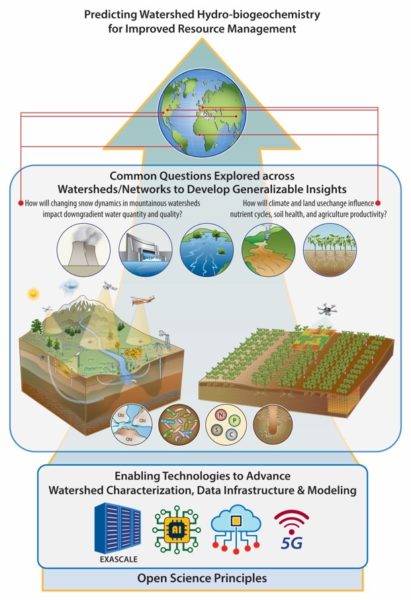
Systematic integration of emerging technologies into watershed network and collaboration strategies hold potential to significantly advance predictive understanding of watershed hydrobiogeochemical behavior.
This invited commentary documented how the emerging technologies listed above are starting to advance key elements important for predicting watershed hydrobiogeochemical behavior, including watershed characterization, data and informatics, and modeling. The commentary also described and recommended a systematic community development of co-design strategies, whereby the emerging technologies could seamlessly weave together characterization, data and modeling capabilities across scales, enabling two-way, near-real time feedback between observation and modeling systems.
While society depends on watersheds for clean water, energy, agricultural productivity and other benefits, state-of-the-art scientific tools are not yet regularly used to underpin resource management. Recent advances in emerging technologies – together with instrumented watershed observatories, open-science principles and new modes of collaboration – offer significant potential to transform our ability to address complex scientific questions, develop generalizable insights, and propel accurate yet tractable approaches to predict watershed hydrobiogeochemical behavior. As resource managers struggle to make increasingly difficult decisions in the coming decades, we hope that the concepts described in this commentary will mobilize the scientific enterprise toward the systematic developments needed to provide actionable information over space and time scales useful for such decisions.
Summary
Several emerging technologies are now starting to reveal their promise for greatly enhancing the predictive understanding of watershed hydro-biogeochemical behavior, including machine learning and artificial intelligence, exascale computing, 5G wireless communications, and cloud data storage and compute capacity. We describe a co-design strategy to unify diverse characterization, data and simulation capabilities, allowing near real-time, autonomous communication and feedback between modelling and field observation systems. Paired with watershed observatory networks, open science principles, and radical collaboration strategies, the co-design strategies are expected to enable rapid progress on challenging scientific questions, such as: how do different types of watersheds respond to different stressors, such as climate change, droughts, floods, wildfire, and land-use? How will multiple stressors impact sustainability of municipal, industry, food, and energy systems that rely on water? Can generalizable metrics of resilience be identified and tracked? What is the minimum but sufficient amount of information needed to predict watershed behavior at temporal and spatial scales critical for underpinning resource management decisions? While systematic incorporation of emerging technologies and adoption of new modes of collaboration will require substantial coordination, resources and commitment to overcome technical, social, and organizational barriers, we are encouraged by the many recent efforts focused on advancing collaborations and tools across watershed communities, observatories, and government agencies.
Citation
Hubbard, S.S., C. Varadharajan, Y. Wu, H. Wainwright and D. Dwivedi, Emerging technologies and radical collaboration to advance predictive understanding of watershed hydrobiogeochemistry, Hydrological Processes, 35, DOI: 10.1002/hyp.13807
